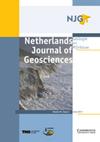Microfauna- and sedimentology-based facies analysis for palaeolandscape reconstruction in the back-barrier area of Norderney (NW Germany)
IF 2.3
2区 地球科学
Q3 GEOSCIENCES, MULTIDISCIPLINARY
Netherlands Journal of Geosciences-Geologie En Mijnbouw
Pub Date : 2021-02-19
DOI:10.1017/njg.2020.16
引用次数: 7
Abstract
Abstract Palaeolandscape reconstructions at the German North Sea coast are essential for the understanding of coastal changes and dynamic landscape-forming processes. This study contributes to reconstructing Holocene coastal changes in the back-barrier area of the East Frisian island of Norderney and draws conclusions on the local palaeogeography. Five sediment cores were analysed in terms of sedimentology (grain-size distribution), geochemistry (TOC, TIC, N, C/N), microfauna (foraminifers and ostracods) and 13 radiocarbon dates. In order to identify driving environmental factors and support the facies interpretation, multivariate statistics (PCA) were carried out. Additional cores from the surrounding area (WASA Project and ‘Landesamt für Bergbau, Energie und Geologie’ (LBEG) Hannover) enabled correlation of the investigated cores over a transect of ~6 km, showing six depositional environments, which can be used for landscape reconstruction. Deposition starts with periglacial (aeolian and glaciofluvial) Pleistocene sediments, with subsequent pedogenesis followed by swamp conditions that develop into a salt marsh. The overlying tidal-flat sediments are partially cut by (fossil and recent) channel deposits. A hiatus at the base of the tidal-flat deposits that spans some 3000 years hints at their reworking caused by a combination of antrophogenic coastal protection measures and the impact of storms. Furthermore, based on the profile correlation and the age data, a widespread salt-marsh area with a minimum age of ~4000 cal BP is defined for the ‘Hohes Riff’ in the southwestern back-barrier of Norderney Island.北德尼(德国西北部)后屏障区古景观重建中基于微动物和沉积学的相分析
德国北海海岸的古景观重建对于理解海岸变化和动态景观形成过程至关重要。本研究有助于重建Norderney东弗里斯兰岛后屏障区全新世海岸变化,并对当地古地理作出结论。对5个沉积物岩心进行了沉积学(粒度分布)、地球化学(TOC、TIC、N、C/N)、微动物群(有孔虫和介形虫)和13个放射性碳测年分析。为了识别驱动环境因素并支持相解释,进行了多元统计分析(PCA)。来自周边地区的其他岩心(WASA项目和“Landesamt fr Bergbau, Energie und Geologie”(LBEG) Hannover)在约6公里的样带上对所调查的岩心进行了对比,显示了6种沉积环境,可用于景观重建。沉积开始于冰缘(风成和冰川河流)更新世沉积物,随后是土壤作用,随后是沼泽条件,发展成盐沼。上覆的潮滩沉积物部分被(古的和近代的)河道沉积物切割。在潮滩沉积物的底部出现了一个跨度约3000年的断裂,这暗示着它们的改造是由海岸保护措施和风暴的影响共同造成的。此外,根据剖面对比和年龄资料,在Norderney岛西南后障壁的“Hohes Riff”中定义了一个广泛的盐沼区,最小年龄约为~4000 cal BP。
本文章由计算机程序翻译,如有差异,请以英文原文为准。
求助全文
约1分钟内获得全文
求助全文
来源期刊
CiteScore
4.00
自引率
25.90%
发文量
14
审稿时长
>12 weeks
期刊介绍:
Netherlands Journal of Geosciences - Geologie en Mijnbouw is a fully open access journal which publishes papers on all aspects of geoscience, providing they are of international interest and quality. As the official publication of the ''Netherlands Journal of Geosciences'' Foundation the journal publishes new and significant research in geosciences with a regional focus on the Netherlands, the North Sea region and relevant adjacent areas. A wide range of topics within the geosciences are covered in the journal, including "geology, physical geography, geophyics, (geo-)archeology, paleontology, hydro(geo)logy, hydrocarbon exploration, modelling and visualisation."
The journal is a continuation of Geologie and Mijnbouw (published by the Royal Geological and Mining Society of the Netherlands, KNGMG) and Mededelingen Nederlands Instituut voor Toegepaste Geowetenschappen (published by TNO Geological Survey of the Netherlands). The journal is published in full colour.

 求助内容:
求助内容: 应助结果提醒方式:
应助结果提醒方式:


